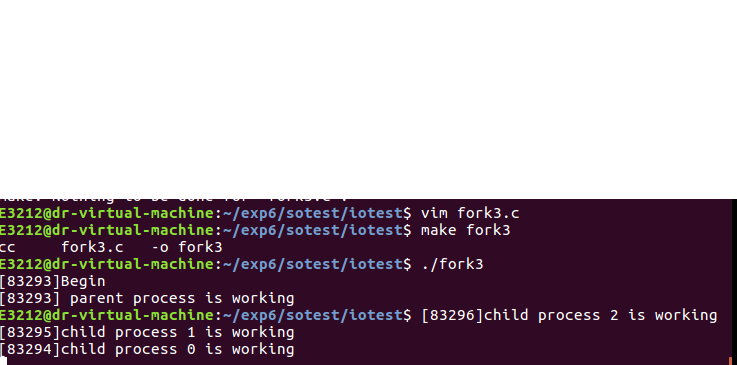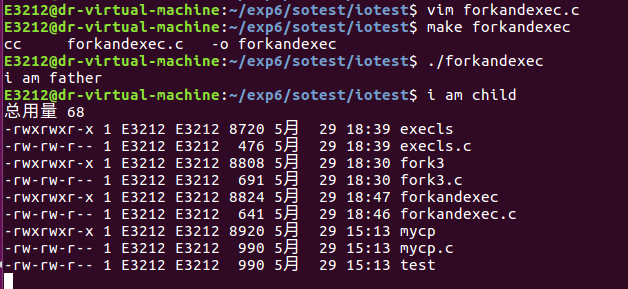实验六 进程基础
| 项目 | 內容 |
|---|---|
| 这个作业属于哪个课程 | 班级课程主要链接 |
| 这个作业的要求在哪里 | 作业要求链接 |
| 学号-姓名 | 18043212-邓锐 |
| 作业学习目标 | 1.掌握Linux系统环境C语言编程概念 2.学习Linux系统进程概念 |
| 1请举例说明静态链接库的创建与使用 | |
| 举例 |
int add(int a,int b){
return a+b;
}
//文件名:sub.c,减法
int sub(int a,int b){
return a-b;
}
//文件名:main.c
#include <stdio.h>
int add(int a,int b);
int sub(int a,int b);
int main(){
printf("3 + 1 = %d\n",add(3,1));
printf("3 - 1 = %d\n",sub(3,1));
return 0;
}



2.请举例说明共享库的创建与使用。
/文件名:common.h
#ifndef _COMMON_
#define _COMMON_
int add(int a,int b);
int sub(int a,int b);
#endif
//文件名:add.c
int add(int a,int b){
return a+b;
}
//文件名:sub.c
int sub(int a,int b){
return a-b;
}
//文件名:main.c
#include<stdio.h>
#include"common.h"
int main(){
printf("3+1=%d\n",add(3,1));
printf("3-1=%d\n",sub(3,1));
}


3.编程实现一个简单文件复制命令。
//文件名:mycp.c
#include <unistd.h>
#include <sys/types.h>
#include <sys/stat.h>
#include <fcntl.h>
#include <stdio.h>
#define BUFFERSIZE 4096
int main(int argc, char* argv[]) {
if (argc != 3) {
printf("usage:\n mycp src dst\n");
return 1;
}
int srcfd = open(argv[1], O_RDONLY);
if (srcfd == -1) {
perror("open");
return 1;
}
int dstfd = open(argv[2], O_CREAT | O_WRONLY, 0666);
if (dstfd == -1) {
close(srcfd);
perror("open");
return 1;
}
int len = 0;
char buffer[BUFFERSIZE] = {0};
while((len = read(srcfd, buffer, BUFFERSIZE)) > 0) {
if (write(dstfd, buffer, len) != len) {
perror("write error");
return 1;
}
}
if (len < 0) {
perror("read error");
return 1;
}
close(srcfd); // 关闭文件
close(dstfd);
return 0;
}


复制后test

4.使用fork创建一个子进程,进程创建成功后父子进程分别输出不同的内容。
///文件名:fork1.c
#include <stdio.h>
#include <stdlib.h>
#include <unistd.h>
int main(){
pid_t pid;
printf("[%d]:Begin! \n",getpid());
fflush(NULL);
pid = fork();
if(pid<0)
{
perror("fork()");
exit(1);
}
else if(pid > 0)
{
printf("[%d]:Parent process if working!\n",getpid());
}
else
{
printf("[%d]:Child process if working!\n",getpid());
}
printf("[%d]:Finish!\n",getpid());
return 0;
}




5.使用fork创建多个子进程。


6在 fork 之前以写的方式创建了一个文件 test.txt。然后 fork 出的子进程立即向文件中写入“world”,然后睡眠5秒。而父进程在 fork 后睡眠3秒后向 test.txt 写入 "hello",并关闭描述符。子进程恢复后,又向 test.txt 文件中写入 "lalala"后关闭描述符,结束




7.分别在主函数中使用execvp启动ls命令以及使用fork函数产生子进程调用execvp启动ls。
#include <stdio.h>
#include <stdlib.h>
#include <unistd.h>
int main(){
char* argv[] = {"ls","-l",NULL};
if (execvp("ls",argv) == -1){
perror("exec");
return 1;
}
return 0;
}


(2)使用fork函数产生子进程调用execvp启动ls命令:


8创建5个僵尸进程,并在终端通过ps axf命令查看僵尸进程信息




9通过wait来清理僵尸进程。






